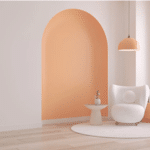
High interest rates create a ripple effect that causes turbulence in the housing market and those industries that depend on homeowners to purchase goods. Contractors are building fewer homes, and potential buyers must contend with skyrocketing costs and a shortage of available housing. While the home improvement industry experienced record sales two years ago, sales have dipped in the past 12 months. Even so, Harvard’s Joint Center for Housing Studies predicts spending will grow 6.5 percent through the third quarter of 2023. The fact that the industry continues to grow in a tight, complex housing market is good news for independent retailers.
So, what’s going on?
People have decided to stay in their current homes and fix them rather than attempting to buy new ones. Interest rates may scare people away from changing homes, but they are willing to remodel and decorate to upgrade and make their homes nicer. Buying home improvement products for aesthetic reasons rather than functional ones is easier when the economy is strong, and people are working. Besides, older homeowners have seen the cycle of high interest rates before—they know what goes up will eventually come down. Owners can afford to sit on the sidelines and wait for more favorable conditions. According to a recent Houzz survey:
- 37 percent of homeowners have completed a project in the past year
- 23 percent of respondents plan to start a project in the next 12 months
A Houzz staff economist, Marine Sargsyan, says, “More than half of the homeowners we surveyed have no intention of selling or moving out of their current residences in the next 20 years—or ever.”
Home Improvement is the Place to Be
According to the Census Bureau, in 2006, 15 percent of homes were new construction. That figure dropped to 7 percent in 2019. However, during the same time, the percentage of housing stock 50 years or older increased from 30 percent to 37 percent. Studies also indicate that 40 percent of the homes in the country are mortgage-free, and those with existing mortgages were purchased when interest rates were low. Typically, housing market downturns significantly slow home improvement store sales. The dynamics are different today than in the past. People are being more strategic about spending. Those with money are more cautious about when and where they will purchase.
- The median age of owner-occupied homes is 39 years
- Half of the owner-occupied homes were built before 1980
- Thirty-eight percent of homes were built before 1970
It’s predicted that prices in core home improvement categories will continue to rise this year due to inflation, then gradually decline during the next three years.
Growing Market for DIY Refresh and Remodels
Businesses such as home furnishings and interior decorators are shifting their focus from new construction to opportunities connecting them to homeowners interested in improving their current residences. Independent home improvement retailers are deeply rooted in communities with older housing stock and have the flexibility to adjust product assortments to accommodate their customers. For stores to compete with big box retailers, it’s essential to enable shoppers to trade up to more expensive and sophisticated products. Often, the goal is to replace old and obsolete objects with those that offer more convenience and style and are easier to use. The most popular areas being remodeled are bathrooms (37 percent) and kitchens (33 percent).
Many more extensive independent operations with customers who are professionals stock enough products to complete these projects from start to finish. But small-to-medium stores that see the big picture can increase sales by promoting faucets, plumbing supplies, lighting, lumber, decorative hardware, and paint. Additionally, the Home Improvement Research Institute identified the top-growing merchandise lines between 2022 and 2026:
- Lawn and garden equipment and supplies: 4.8 percent
- Nursery stock and soil treatments: 4.0 percent
- Paint and preservatives: 3.8 percent
Even in times of high inflation and rising costs, independent retailers can remain authentic and move forward in uncertain times by playing to their strengths. Selling quality products, giving knowledgeable advice, and providing exceptional service wins every time.




